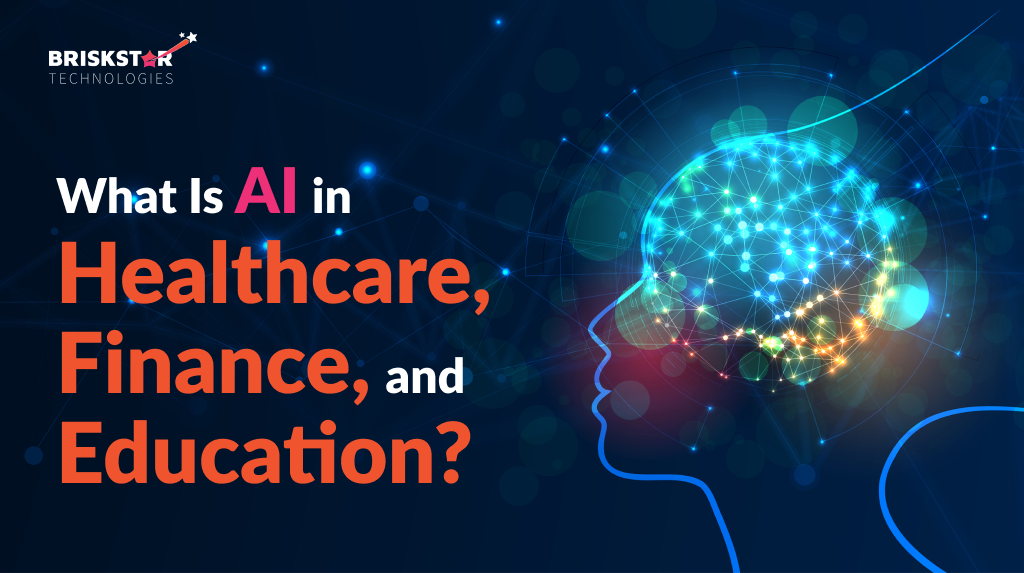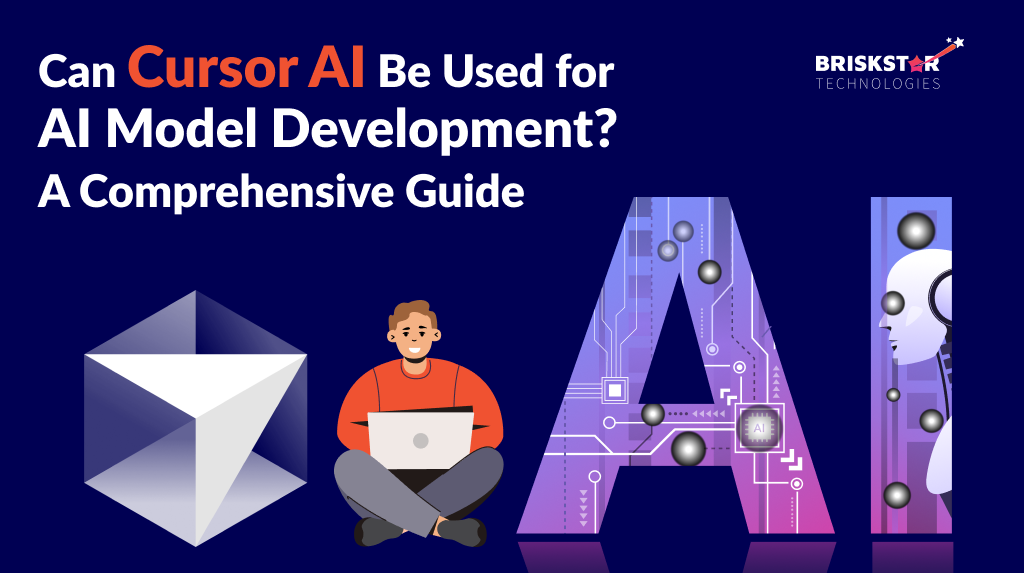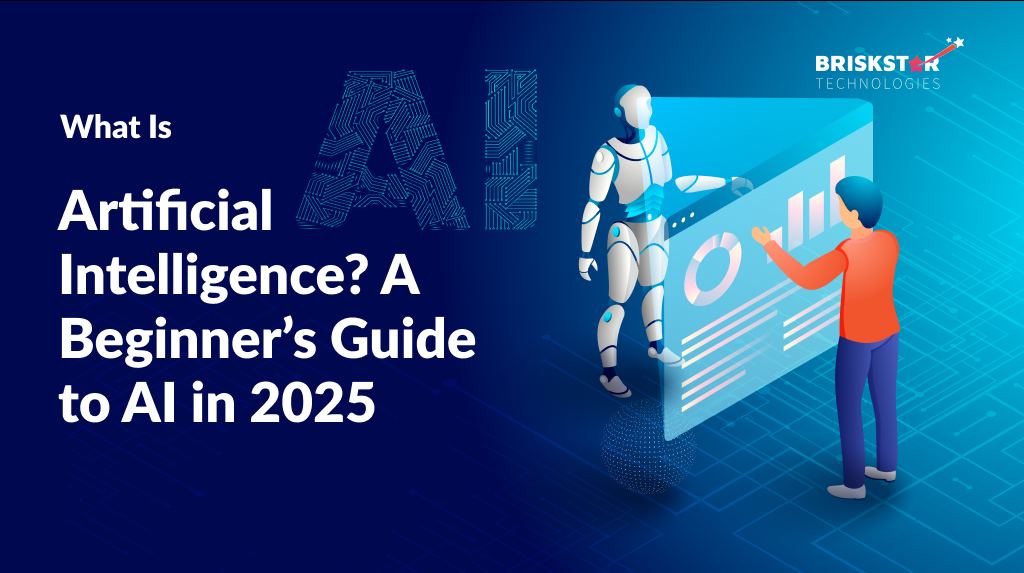What Is Artificial Intelligence in Healthcare, Finance, and Education?
What is Artificial Intelligence?
Artificial Intelligence represents a revolutionary paradigm in computer science that enables machines to simulate human cognitive functions including learning, reasoning, problem-solving, perception, and language understanding. AI encompasses various sophisticated technologies including machine learning algorithms that improve performance through experience, deep learning neural networks that mimic human brain structures, natural language processing systems that understand and generate human language, computer vision technologies that interpret visual information, and robotics that combine AI with physical manipulation capabilities. These systems process vast amounts of data to identify patterns, make predictions, and execute complex tasks that traditionally required human intelligence, fundamentally transforming how we approach problems across multiple industries.
AI in Healthcare: Revolutionary Medical Transformation
Medical Imaging and Advanced Diagnostics
Artificial intelligence has fundamentally transformed medical imaging by introducing unprecedented levels of accuracy and speed in diagnostic procedures. Modern AI systems can analyze radiological images including X-rays, computed tomography scans, magnetic resonance imaging, mammograms, and ultrasounds with superhuman precision. These systems utilize convolutional neural networks trained on millions of medical images to detect subtle abnormalities that might escape human observation. For instance, Google’s DeepMind has developed AI systems that can diagnose over 50 eye diseases with 94% accuracy, while IBM Watson for Oncology analyzes cancer images to recommend treatment options. The technology excels in early detection of cancers, identification of microscopic fractures, assessment of cardiovascular conditions, and monitoring disease progression over time. AI-powered pathology systems can examine tissue samples at the cellular level, identifying cancerous cells and predicting tumor behavior with remarkable accuracy. These advances significantly reduce diagnostic errors, accelerate treatment initiation, and improve patient outcomes while reducing the workload on radiologists and pathologists.
Drug Discovery and Pharmaceutical Innovation
The pharmaceutical industry has embraced AI to revolutionize the traditionally lengthy and expensive drug development process. AI algorithms analyze molecular structures, predict drug-target interactions, identify potential side effects, and optimize chemical compounds for maximum efficacy. Machine learning models can process vast chemical databases to identify promising drug candidates, reducing the initial screening phase from years to months. Companies like Atomwise use AI to predict how different compounds will behave in the human body, while Benevolent AI has successfully identified existing drugs that could be repurposed for new conditions. AI also optimizes clinical trial design by identifying suitable patient populations, predicting trial outcomes, and monitoring patient responses in real-time. The technology can analyze genetic data to understand how different populations might respond to medications, enabling the development of more targeted therapies. Furthermore, AI accelerates the identification of biomarkers for diseases, facilitates the understanding of disease mechanisms, and supports the development of personalized medicine approaches that consider individual genetic profiles.
Personalized Treatment and Precision Medicine
AI enables unprecedented personalization in healthcare by analyzing individual patient data to create tailored treatment plans. These systems consider genetic information, medical history, lifestyle factors, environmental influences, current symptoms, and response to previous treatments to recommend optimal therapeutic approaches. Machine learning algorithms can predict how patients will respond to specific medications, helping physicians select the most effective drugs while minimizing adverse reactions. For example, AI systems in oncology analyze tumor genetics to recommend targeted cancer therapies, while psychiatric applications use patient data to optimize antidepressant selection. The technology also supports personalized dosing recommendations, taking into account factors like age, weight, kidney function, and genetic variations in drug metabolism. AI-powered clinical decision support systems provide real-time recommendations during patient consultations, alerting physicians to potential drug interactions, contraindications, and evidence-based treatment protocols. This personalized approach leads to improved treatment outcomes, reduced side effects, enhanced patient satisfaction, and more efficient use of healthcare resources.
Robotic Surgery and Surgical Assistance
AI-powered surgical robotics represents a significant advancement in surgical precision and capability. These systems combine artificial intelligence with advanced robotics to enhance surgical outcomes through improved precision, reduced invasiveness, and enhanced surgeon capabilities. The da Vinci Surgical System, enhanced with AI capabilities, allows surgeons to perform minimally invasive procedures with enhanced dexterity and control. AI algorithms can analyze real-time surgical video feeds to provide guidance, identify anatomical structures, and alert surgeons to potential complications. Advanced systems can predict optimal surgical approaches based on patient anatomy, simulate surgical procedures for training purposes, and even perform certain routine surgical tasks autonomously under physician supervision. Machine learning algorithms analyze surgical outcomes data to continuously improve techniques and identify best practices. The technology also enables remote surgery, where expert surgeons can operate on patients in distant locations using AI-enhanced robotic systems. These advances result in reduced surgical complications, shorter recovery times, decreased hospital stays, and improved access to specialized surgical expertise in underserved areas.
Virtual Health Assistants and Telemedicine
AI-powered virtual health assistants have transformed patient engagement and healthcare accessibility by providing 24/7 medical support and guidance. These sophisticated systems use natural language processing to understand patient inquiries, provide evidence-based health information, conduct preliminary symptom assessments, and guide patients to appropriate care levels. Advanced virtual assistants can monitor chronic conditions, remind patients about medications, track vital signs through connected devices, and alert healthcare providers to concerning changes in patient status. Companies like Babylon Health and Ada Health have developed AI diagnostic tools that can assess symptoms and provide medical recommendations with accuracy comparable to human physicians for common conditions. These systems also support medication adherence by sending personalized reminders, providing educational content about treatments, and monitoring side effects. Virtual assistants facilitate telemedicine consultations by preparing patient information, conducting pre-visit assessments, and providing real-time translation services for international patients. The technology democratizes healthcare access, particularly benefiting rural and underserved populations who may have limited access to medical specialists.
Predictive Analytics and Population Health Management
AI-driven predictive analytics in healthcare enables proactive intervention and population health management by analyzing vast amounts of health data to identify patterns and predict future health events. These systems can forecast disease outbreaks by analyzing environmental data, travel patterns, and reported symptoms across populations. Machine learning algorithms identify patients at high risk for conditions like heart attacks, strokes, diabetes complications, and hospital readmissions, enabling preventive interventions. For example, AI systems can analyze electronic health records to predict which patients are likely to develop sepsis, allowing for early intervention that can save lives. Population health management platforms use AI to identify health trends, resource needs, and intervention opportunities across large patient populations. The technology also supports epidemiological research by identifying disease patterns, tracking treatment effectiveness, and predicting the spread of infectious diseases. Healthcare organizations use predictive analytics to optimize staffing levels, manage bed capacity, and allocate resources efficiently. These capabilities lead to improved patient outcomes, reduced healthcare costs, and more effective public health responses.
Electronic Health Records and Health Information Management
AI transforms the management and utilization of electronic health records by extracting meaningful insights from vast amounts of unstructured medical data. Natural language processing algorithms can analyze physician notes, lab reports, imaging studies, and other clinical documents to identify relevant medical information, extract key data points, and organize information for easy access. These systems can automatically code diagnoses and procedures, reducing administrative burden on healthcare providers while improving billing accuracy. AI-powered clinical documentation systems can transcribe physician-patient conversations, generate clinical notes, and suggest relevant medical codes in real-time. Machine learning algorithms analyze EHR data to identify potential medical errors, flag drug interactions, and suggest evidence-based treatment recommendations. The technology also enables advanced clinical research by identifying patient cohorts, tracking treatment outcomes, and facilitating the development of clinical guidelines. AI systems can integrate data from multiple sources including wearable devices, laboratory systems, and imaging platforms to provide comprehensive patient profiles that support clinical decision-making.
Benefits and Transformative Impact in Healthcare
The integration of AI in healthcare delivers numerous transformative benefits that revolutionize patient care and healthcare delivery. Enhanced diagnostic accuracy significantly reduces misdiagnosis rates and enables earlier detection of diseases, leading to better treatment outcomes and improved survival rates. AI systems work continuously without fatigue, providing consistent analysis and reducing human error in critical medical decisions. The technology dramatically accelerates the pace of medical research and drug development, potentially bringing life-saving treatments to market years earlier than traditional methods. Cost reduction occurs through improved efficiency, reduced unnecessary procedures, optimized resource allocation, and prevention of costly medical complications. AI democratizes access to high-quality medical expertise, particularly benefiting underserved populations who may lack access to specialist care. Personalized medicine approaches improve treatment effectiveness while reducing side effects, leading to better patient experiences and outcomes. The technology also supports preventive healthcare by identifying risk factors early and enabling proactive interventions that prevent disease progression.
Challenges and Critical Considerations in Healthcare AI
Despite its transformative potential, AI implementation in healthcare faces significant challenges that must be carefully addressed. Data privacy and security concerns are paramount, as medical information is highly sensitive and subject to strict regulatory requirements like HIPAA. Ensuring AI transparency and explainability is crucial for physician acceptance and regulatory approval, as medical decisions must be justifiable and understandable. Algorithmic bias represents a significant risk, as AI systems trained on non-representative datasets may perpetuate healthcare disparities or provide suboptimal care for certain populations. Integration with existing healthcare systems requires substantial technical infrastructure and workflow modifications that can be costly and disruptive. Regulatory approval processes for AI medical devices are complex and evolving, creating uncertainty for developers and healthcare organizations. Physician training and change management are essential but challenging, as healthcare providers must learn to work effectively with AI tools while maintaining clinical judgment. Liability and malpractice considerations become complex when AI systems are involved in medical decision-making, requiring new legal frameworks and insurance models.
AI in Finance: Transforming Financial Services
Algorithmic Trading and Market Operations
Artificial intelligence has revolutionized financial markets through sophisticated algorithmic trading systems that execute transactions at speeds and scales impossible for human traders. These AI-powered systems analyze vast amounts of market data including price movements, trading volumes, news sentiment, economic indicators, and social media trends to identify profitable trading opportunities within microseconds. High-frequency trading algorithms can execute thousands of trades per second, capitalizing on minute price discrepancies across different markets and exchanges. Machine learning models continuously adapt to changing market conditions, learning from historical patterns while adjusting strategies based on real-time data. Quantitative hedge funds like Renaissance Technologies and Two Sigma employ AI to develop complex trading strategies that consider hundreds of variables simultaneously. Natural language processing systems analyze news articles, earnings reports, and regulatory filings to gauge market sentiment and predict price movements. AI also enables portfolio optimization by dynamically adjusting asset allocations based on risk tolerance, market conditions, and investment objectives. These systems can identify arbitrage opportunities, execute complex multi-asset trades, and manage risk exposure across global markets 24/7, significantly improving trading efficiency and profitability.
Fraud Detection and Financial Security
AI-powered fraud detection systems represent a critical defense mechanism for financial institutions, protecting billions of dollars in assets and maintaining customer trust. These sophisticated systems analyze transaction patterns, user behavior, device fingerprints, and contextual information to identify suspicious activities in real-time. Machine learning algorithms can detect anomalies that deviate from normal spending patterns, flagging potentially fraudulent transactions for immediate review. For example, if a customer typically makes purchases in New York but suddenly attempts a large transaction in a foreign country, AI systems can flag this as suspicious and temporarily block the transaction for verification. Advanced systems use behavioral biometrics to analyze typing patterns, mouse movements, and mobile device usage to verify user identity continuously. Deep learning networks can identify sophisticated fraud schemes that evolve over time, adapting to new attack vectors and criminal techniques. AI also combats identity theft by analyzing multiple data points to verify customer identities during account opening and high-risk transactions. Financial institutions like JPMorgan Chase and Mastercard have reported significant reductions in fraud losses and false positives through AI implementation, improving both security and customer experience.
Credit Scoring and Risk Assessment Innovation
Traditional credit scoring methods are being transformed by AI systems that can analyze vastly more data points to assess creditworthiness and default risk. Machine learning algorithms consider not only traditional financial data like payment history and debt-to-income ratios but also alternative data sources including social media activity, online shopping behavior, utility payments, and even smartphone usage patterns. These comprehensive assessments enable more accurate risk predictions and can extend credit access to previously underserved populations who lack traditional credit histories. AI models can identify subtle patterns that predict loan performance, such as the correlation between application completion time and default risk. Companies like Upstart and ZestFinance have demonstrated that AI-enhanced credit models can approve more loans while maintaining lower default rates compared to traditional scoring methods. The technology also enables dynamic pricing based on real-time risk assessment, adjusting interest rates and credit limits as customer circumstances change. AI systems can process loan applications in minutes rather than days, dramatically improving customer experience while reducing operational costs for lenders.
Robo-Advisors and Automated Investment Management
Robo-advisors represent a democratization of investment management through AI-powered platforms that provide sophisticated portfolio management services at a fraction of traditional advisory costs. These systems use algorithms to assess investor risk tolerance, financial goals, and time horizons to create personalized investment portfolios typically composed of low-cost exchange-traded funds. Companies like Betterment, Wealthfront, and Vanguard Digital Advisor manage billions in assets through automated rebalancing, tax-loss harvesting, and goal-based investing strategies. Advanced robo-advisors incorporate behavioral finance principles to help investors avoid common psychological biases that lead to poor investment decisions. AI algorithms continuously monitor market conditions and automatically adjust portfolios to maintain target asset allocations and optimize tax efficiency. Some platforms offer hybrid models that combine AI automation with human advisor oversight for complex financial planning needs. The technology also provides personalized financial education and guidance, helping users understand investment concepts and make informed decisions about their financial futures. These platforms have made professional-quality investment management accessible to middle-class investors who previously couldn’t afford traditional advisory services.
Customer Service Automation and Digital Banking
AI-powered customer service systems have transformed banking operations by providing 24/7 support, reducing wait times, and improving service quality while significantly reducing operational costs. Sophisticated chatbots and virtual assistants can handle a wide range of customer inquiries including account balances, transaction history, bill payments, and basic troubleshooting without human intervention. Natural language processing enables these systems to understand customer intent even when expressed in casual or ambiguous language, providing appropriate responses and solutions. Voice-enabled banking through platforms like Amazon Alexa and Google Assistant allows customers to check balances, pay bills, and transfer funds using simple voice commands. AI systems can analyze customer interaction history to provide personalized recommendations for financial products and services that match individual needs and preferences. Advanced systems use sentiment analysis to detect frustrated or confused customers and automatically escalate these interactions to human agents with relevant context information. Banks like Bank of America with Erica and JPMorgan Chase with Amy have successfully deployed AI assistants that handle millions of customer interactions monthly, improving satisfaction while reducing support costs.
Regulatory Compliance and Risk Management
RegTech applications of AI help financial institutions navigate the complex and ever-changing regulatory landscape by automating compliance monitoring, reporting, and risk management processes. Machine learning algorithms can analyze vast amounts of transaction data to detect patterns indicative of money laundering, terrorist financing, and other financial crimes. These systems can identify suspicious transaction networks, unusual account behaviors, and potential sanctions violations with greater accuracy and speed than traditional rule-based systems. AI-powered Know Your Customer (KYC) systems can verify customer identities, screen against watchlists, and assess ongoing risk levels automatically. Natural language processing analyzes regulatory changes and updates compliance rules across multiple jurisdictions, ensuring institutions remain current with evolving requirements. AI also supports stress testing and scenario analysis by modeling potential market conditions and their impact on portfolio performance. Regulatory reporting becomes more efficient through automated data collection, validation, and submission processes. These technologies significantly reduce compliance costs while improving the accuracy and timeliness of regulatory obligations.
Insurance Technology and Claims Processing
AI is revolutionizing the insurance industry through automated underwriting, claims processing, and fraud detection capabilities that improve efficiency and accuracy while reducing costs. Machine learning algorithms analyze risk factors including demographics, lifestyle data, telematics information, and historical claims to price policies more accurately and identify high-risk applicants. Usage-based insurance models use AI to analyze driving behavior through smartphone apps or vehicle telematics to adjust premiums based on actual risk exposure. Claims processing has been transformed through computer vision systems that can assess vehicle damage, property damage, and medical conditions through photograph analysis, enabling instant claim approvals for straightforward cases. Natural language processing automates the analysis of medical records and police reports to expedite claim investigations. AI-powered chatbots guide customers through the claims process, collecting necessary information and providing status updates automatically. Fraud detection systems analyze claim patterns, cross-reference databases, and identify suspicious activities that warrant human investigation. Companies like Lemonade and Root Insurance have built their business models around AI-first approaches, demonstrating significant improvements in customer experience and operational efficiency.
Market Analysis and Investment Research
AI has transformed financial research and market analysis by processing vast amounts of structured and unstructured data to generate investment insights and trading strategies. Machine learning algorithms analyze corporate earnings reports, SEC filings, analyst reports, and news articles to extract relevant financial information and sentiment indicators. Natural language processing systems can read and interpret complex financial documents faster and more consistently than human analysts, identifying key trends and risks across thousands of companies simultaneously. AI-powered sentiment analysis monitors social media, news articles, and analyst commentary to gauge market mood and predict price movements. Satellite imagery analysis provides alternative data insights, such as monitoring retail parking lots to predict earnings or tracking oil tanker movements to forecast commodity prices. AI systems can identify correlations between seemingly unrelated factors, such as weather patterns and agricultural commodity prices or geopolitical events and currency fluctuations. Quantitative research platforms use machine learning to backtest trading strategies across historical data and optimize parameters for maximum risk-adjusted returns. These capabilities enable more informed investment decisions and the development of sophisticated trading strategies that adapt to changing market conditions.
Benefits and Competitive Advantages in Finance
The implementation of AI in finance delivers substantial benefits that create competitive advantages and improve financial services quality. Operational efficiency gains are dramatic, with AI systems processing transactions and analyzing data far faster than human capabilities allow. Cost reduction occurs through automation of routine tasks, reduced error rates, and optimized resource allocation across financial operations. Risk management improves significantly through better prediction capabilities, real-time monitoring, and more accurate assessment of various risk factors. Customer experience enhancement comes from personalized services, faster response times, and more convenient access to financial products and services. AI enables financial inclusion by extending services to previously underserved populations through alternative credit scoring and automated processes that reduce barriers to access. Compliance costs decrease while accuracy improves through automated monitoring and reporting systems. Innovation acceleration allows financial institutions to develop new products and services that were previously impossible or economically unfeasible. Market efficiency increases as AI systems identify and eliminate arbitrage opportunities while improving price discovery mechanisms.
Challenges and Risk Considerations in Financial AI
Despite significant benefits, AI implementation in finance faces substantial challenges that require careful management and oversight. Algorithmic bias can perpetuate or amplify existing inequalities in financial services, potentially discriminating against certain demographic groups in lending, insurance, or investment decisions. Systemic risk concerns arise as similar AI systems across multiple institutions could create correlated behaviors that amplify market volatility or contribute to financial instability. Regulatory uncertainty creates challenges as financial authorities work to develop appropriate oversight frameworks for AI systems without stifling innovation. Cybersecurity risks increase as AI systems become targets for sophisticated attacks aimed at manipulating algorithms or stealing sensitive financial data. Explainability requirements conflict with the “black box” nature of some AI systems, making it difficult to understand and justify automated decisions in regulated environments. Data quality and availability issues can compromise AI effectiveness, particularly when systems are trained on biased or incomplete datasets. Workforce displacement concerns affect employment in traditional financial services roles, requiring significant retraining and adaptation efforts. Market manipulation risks emerge as bad actors potentially use AI to create false market signals or engage in coordinated trading schemes.
AI in Education: Personalizing Learning for Every Student
Personalized Learning Systems and Adaptive Education
Artificial intelligence is revolutionizing education through personalized learning systems that adapt to individual student needs, learning styles, and pace preferences. These sophisticated platforms analyze student performance data, engagement patterns, and learning behaviors to create customized educational experiences that optimize learning outcomes for each individual. Adaptive learning algorithms continuously adjust content difficulty, presentation style, and pacing based on real-time assessment of student comprehension and progress. For example, if a student struggles with algebraic concepts, the system might provide additional practice problems, alternative explanations, or prerequisite review materials before advancing to more complex topics. Companies like Khan Academy, Coursera, and edX use AI to recommend learning paths, suggest relevant content, and predict which topics students might find challenging. These systems can identify knowledge gaps early and provide targeted interventions to prevent learning difficulties from compounding. Machine learning algorithms analyze successful learning patterns to optimize content delivery, determining the most effective sequence of concepts and the optimal timing for reviews and assessments. Personalized learning extends beyond academic content to include study schedule optimization, learning environment preferences, and motivational strategies tailored to individual student psychology.
Intelligent Tutoring Systems and Virtual Teaching Assistants
AI-powered intelligent tutoring systems provide individualized instruction that simulates one-on-one tutoring experiences at scale. These systems use natural language processing to engage students in conversational learning, answering questions, providing explanations, and offering hints and guidance similar to human tutors. Advanced systems like Carnegie Learning’s MATHia and Squirrel AI can identify student misconceptions, provide targeted feedback, and adapt teaching strategies based on individual learning needs. Virtual teaching assistants handle routine inquiries about course logistics, assignment due dates, and basic concept explanations, freeing human instructors to focus on complex pedagogical tasks and personal student support. These AI tutors can work 24/7, providing immediate assistance when students need help outside traditional classroom hours. Machine learning algorithms analyze student interaction patterns to identify optimal teaching strategies for different learning styles and personality types. The systems can provide multiple explanations for the same concept, using different approaches until students achieve understanding. AI tutors also track emotional states through text analysis and engagement metrics, adjusting their approach when students show signs of frustration or confusion.
Automated Assessment and Intelligent Feedback Systems
AI has transformed educational assessment by automating grading processes and providing sophisticated feedback that goes beyond simple right-wrong evaluations. Natural language processing systems can evaluate essays, short answer responses, and complex problem solutions, providing detailed feedback on content quality, argument structure, writing mechanics, and conceptual understanding. These systems analyze student work against multiple criteria, identifying strengths and areas for improvement while providing specific suggestions for enhancement. Automated essay scoring platforms like ETS’s e-rater and Pearson’s WriteToLearn can assess writing quality with reliability comparable to human graders while providing immediate feedback that helps students improve their writing skills. AI systems can also generate practice questions and assessments tailored to individual student needs, creating endless variations of problems that test the same concepts without repetition. Formative assessment tools use AI to analyze student responses during learning activities, providing real-time feedback that helps students correct misconceptions immediately rather than waiting for formal test results. These systems can identify partial understanding and provide scaffolded support to help students reach full comprehension.
Predictive Analytics for Student Success and Intervention
Educational institutions increasingly use AI-driven predictive analytics to identify students at risk of academic failure, dropout, or other challenges, enabling proactive interventions that improve student success rates. Machine learning algorithms analyze diverse data sources including academic performance, attendance patterns, engagement with online learning platforms, library usage, and even dining hall visits to identify early warning signs of student difficulties. Universities like Georgia State University have successfully used predictive analytics to identify at-risk students and provide targeted support, resulting in significant improvements in graduation rates and reductions in achievement gaps. These systems can predict which students might struggle in specific courses based on their academic history and learning patterns, allowing advisors to recommend additional support resources or alternative course sequences. Predictive models also help institutions optimize resource allocation by forecasting demand for tutoring services, mental health support, and academic accommodations. AI systems can identify students who would benefit from specific interventions such as peer mentoring, study groups, or specialized academic support programs. The technology enables personalized outreach strategies, determining the most effective communication methods and timing for engaging with individual students.
Language Learning and Global Education Access
AI has transformed language learning through personalized instruction systems that adapt to individual learning styles, provide immediate feedback, and create immersive practice environments. Applications like Duolingo, Babbel, and Rosetta Stone use machine learning algorithms to optimize lesson sequences, adjust difficulty levels, and provide personalized practice recommendations based on individual progress and retention patterns. Speech recognition technology enables AI systems to provide pronunciation feedback, helping learners develop accurate speaking skills through real-time analysis and correction. Natural language processing powers conversational AI tutors that engage students in dialogue practice, providing a safe environment to practice speaking skills without fear of judgment. AI-powered translation tools bre
![circle-shapes]()











